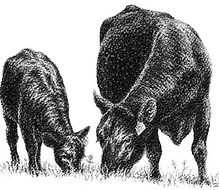
Shew Family Farm
100% Grass-fed & Grass-Finished Angus Beef
Contact Pete & Marjie Shew 740 651-7370
What Does Grass Fed Mean?
Grass fed means that the livestock graze on growing pastures from birth until they are "finished". At Shew's Family Farm, our livestock are "finished" (fattened) to approximately 800 - 1000lbs liveweight completely on hay and natural pasture grass. They receive no grain and spend no time in feedlots or confinement facilities. After processing, our beef is dry aged to increase tenderness. No Antibiotics, GMOs, Hormones, or other chemicals are used.
Products from pastured animals are ideal for human health. Very similar to wild game, they contain the amounts and kinds of nutrients that our bodies "expect" to be fed. The research suggests that switching to grass-fed products may reduce the risk of a number of diseases, including diabetes, obesity, cardiovascular disease, and cancer.
Because grass-fed meat is so lean, it is also lower in calories. Fat has 9 calories per gram, compared with only 4 calories for protein. The greater the fat content, the greater the number of calories. A 6-ounce steak from a grass-finished steer has almost 100 fewer calories than a 6-ounce steak from a grain-fed steer. If you eat a typical amount of beef (66.5 pounds a year average in the US), switching to grass-fed beef will save you 17,733 calories a year--without requiring any willpower or change in eating habits. If everything else in your diet remains constant, you'll lose about six pounds a year. If all Americans switched to grass-fed meat, our national epidemic of obesity might begin to diminish.
Cooking Information
1. Your biggest thing to watch out for with grass fed beef is overcooking. If you like well done beef, then cook your grass fed beef at very low temperatures in a sauce to add moisture.
2. Since grass fed beef is extremely low in fat, coat with virgin olive oil, or a favorite light oil for flavor enhancement and easy browning. The oil will also prevent drying and sticking.
3. You may also use sauces or marinades to enhance the flavor of the meat. Choose a recipe that doesn't mask the delicate flavor of grass fed beef but enhances the moisture content. A favorite marinade using lemon, vinegar, etc. is a great choice. Some people use their favorite Italian salad dressing. For safe handling, always marinate in the refrigerator.
4. We highly recommend stove top cooking for our Ground Beef. Since grass-fed beef is so lean, grilled hamburgers can be dry unless using a sauce. You also have more control over the temperature than on the grill. You can use butter or olive oil in the final minutes when the heat is low to carry the taste through the meat just like steak chefs.
5. Grass fed beef has high protein and low fat levels, the beef will usually require 30% less cooking time and will continue to cook when removed from heat. For this reason, remove the beef from your heat source 10 degrees before it reaches the desired temperature.
6. When first using our Ground Beef, you may want to use a thermometer to test for doneness and watch the thermometer carefully. Since grass fed beef cooks so quickly, your beef can go from perfectly cooked to overcooked in less than a minute.
7. Never use a microwave to thaw your grass fed beef. Either thaw your beef in the refrigerator or for quick thawing place package in cold water for a few minutes.
8. Always pre-heat your oven, pan or grill before cooking grass fed beef.
9. When grilling, sear the meat quickly over a high heat on each side to seal in its natural juices and then reduce the heat to a medium or low to finish the cooking process. Also, baste to add moisture throughout the grilling process.
10. When preparing hamburgers on the grill, use caramelized onions, olives or roasted peppers to add low fat moisture to the meat while cooking. We add zero fat to our burgers (they are 85% to 90% lean) . . . so some moisture may be needed to compensate for the lack of fat. Make sure you do not overcook your burgers . . . 30% less cooking time is required.